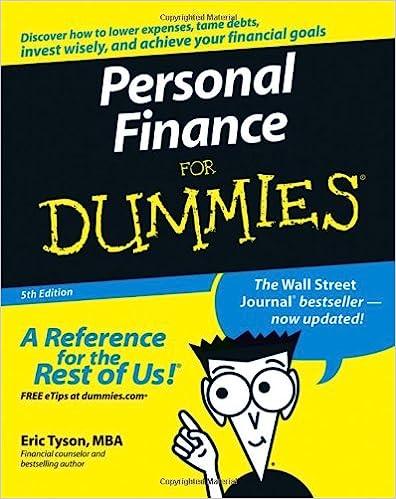Answered step by step
Verified Expert Solution
Question
1 Approved Answer
If you were in the position of Richard Kielstra, what would be your analysis of the situation regarding the surplus resin? the headcount target of
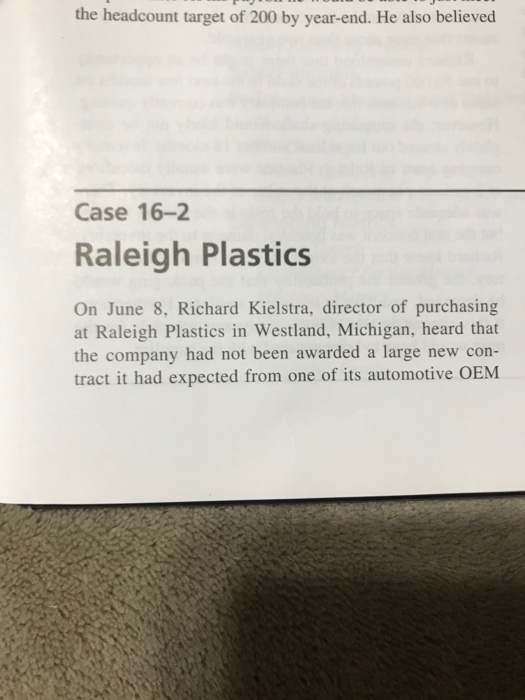
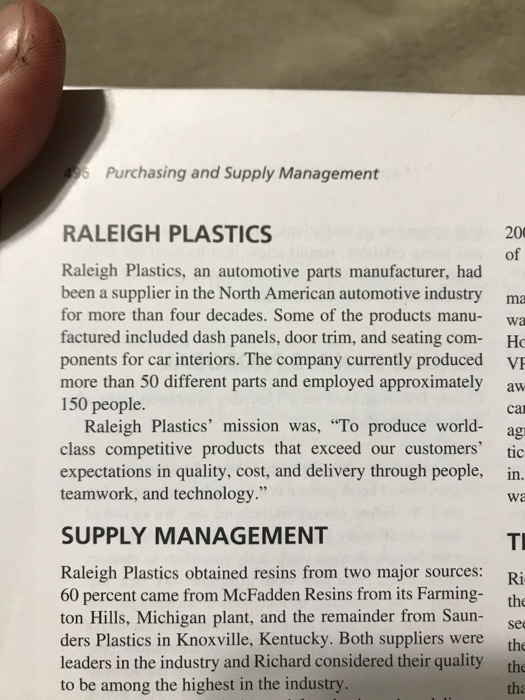
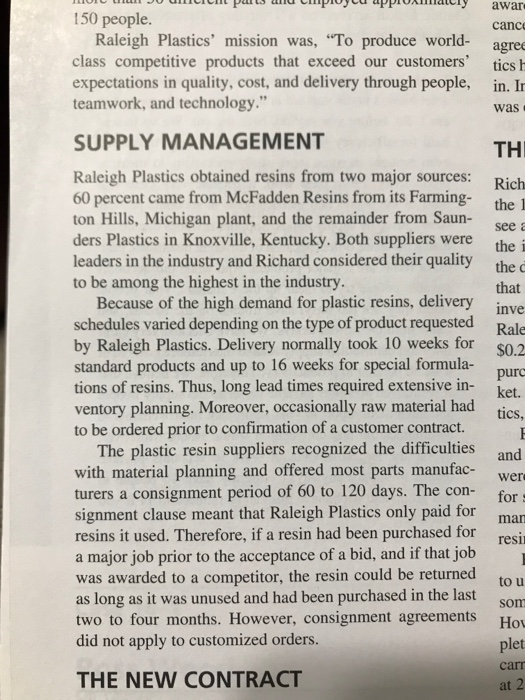
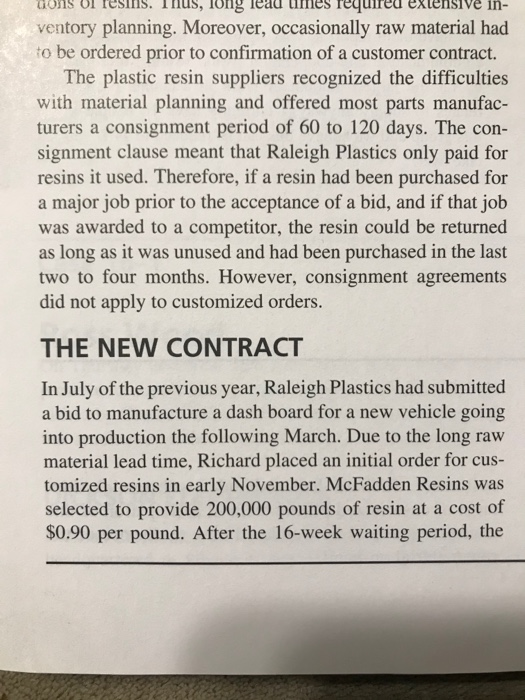

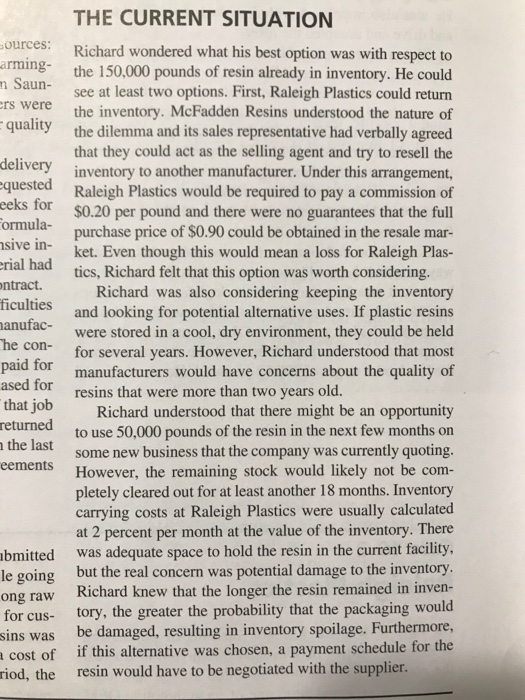
If you were in the position of Richard Kielstra, what would be your analysis of the situation regarding the surplus resin?
the headcount target of 200 by year-end. He also believed Case 16-2 Raleigh Plastics On June 8, Richard Kielstra, director of purchasing at Raleigh Plastics in Westland, Michigan, heard that the company had not been awarded a large new con- tract it had expected from one of its automotive OEM Purchasing and Supply Management ma wa RALEIGH PLASTICS 200 of Raleigh Plastics, an automotive parts manufacturer, had been a supplier in the North American automotive industry for more than four decades. Some of the products manu- factured included dash panels, door trim, and seating com- Hc ponents for car interiors. The company currently produced VE more than 50 different parts and employed approximately 150 people. Raleigh Plastics' mission was, To produce world- ag class competitive products that exceed our customers' tic expectations in quality, cost, and delivery through people, teamwork, and technology." aw wa SUPPLY MANAGEMENT TI Ri the sec Raleigh Plastics obtained resins from two major sources: 60 percent came from McFadden Resins from its Farming- ton Hills, Michigan plant, and the remainder from Saun- ders Plastics in Knoxville, Kentucky. Both suppliers were leaders in the industry and Richard considered their quality to be among the highest in the industry. the the tha awar cance 150 people. Raleigh Plastics' mission was, To produce world- agrec class competitive products that exceed our customers' tics expectations in quality, cost, and delivery through people, in. In teamwork, and technology." was Rich see a the c SUPPLY MANAGEMENT THI Raleigh Plastics obtained resins from two major sources: 60 percent came from McFadden Resins from its Farming- the 1 ton Hills, Michigan plant, and the remainder from Saun- ders Plastics in Knoxville, Kentucky. Both suppliers were the i leaders in the industry and Richard considered their quality to be among the highest in the industry. that Because of the high demand for plastic resins, delivery inve schedules varied depending on the type of product requested Rale by Raleigh Plastics. Delivery normally took 10 weeks for $0.2 standard products and up to 16 weeks for special formula- purc tions of resins. Thus, long lead times required extensive in- ket. ventory planning. Moreover, occasionally raw material had tics, to be ordered prior to confirmation of a customer contract. E The plastic resin suppliers recognized the difficulties and with material planning and offered most parts manufac- turers a consignment period of 60 to 120 days. The con- signment clause meant that Raleigh Plastics only paid for resins it used. Therefore, if a resin had been purchased for resil a major job prior to the acceptance of a bid, and if that job was awarded to a competitor, the resin could be returned as long as it was unused and had been purchased in the last two to four months. However, consignment agreements Hoy did not apply to customized orders. plet THE NEW CONTRACT wer for man to u som carr at 2 DO in- long required ventory planning. Moreover, occasionally raw material had to be ordered prior to confirmation of a customer contract. The plastic resin suppliers recognized the difficulties with material planning and offered most parts manufac- turers a consignment period of 60 to 120 days. The con- signment clause meant that Raleigh Plastics only paid for resins it used. Therefore, if a resin had been purchased for a major job prior to the acceptance of a bid, and if that job was awarded to a competitor, the resin could be returned as long as it was unused and had been purchased in the last two to four months. However, consignment agreements did not apply to customized orders. THE NEW CONTRACT In July of the previous year, Raleigh Plastics had submitted a bid to manufacture a dash board for a new vehicle going into production the following March. Due to the long raw material lead time, Richard placed an initial order for cus- tomized resins in early November. McFadden Resins was selected to provide 200,000 pounds of resin at a cost of $0.90 per pound. After the 16-week waiting period, the com- 200,000 pounds would be delivered in monthly shipments of 50,000 pounds each. had By March Richard still had not received contract confir- ustry mation. The resin began to accumulate in inventory, but he anu- was not concerned because the plant had adequate space. However, on June 8 Richard learned from the company's Liced VP of sales, Walter Merulla, that the contract had been tely awarded to another supplier. Richard immediately requested cancellation of all remaining deliveries. McFadden Resins orld- agreed to cease all shipments, but by this date Raleigh Plas- ers' tics had already received 150,000 pounds of customized res- ple, in. Inventory had been purchased on credit and the supplier was expecting payment by the end of the month. THE CURRENT SITUATION ces: ng- un- ere Richard wondered what his best option was with respect to the 150,000 pounds of resin already in inventory. He could see at least two options. First, Raleigh Plastics could return THE CURRENT SITUATION ources: Richard wondered what his best option was with respect to arming- the 150,000 pounds of resin already in inventory. He could m Saun- see at least two options. First, Raleigh Plastics could return ers were the inventory. McFadden Resins understood the nature of quality the dilemma and its sales representative had verbally agreed delivery that they could act as the selling agent and try to resell the inventory to another manufacturer. Under this arrangement, equested Raleigh Plastics would be required to pay a commission of weeks for $0.20 per pound and there were no guarantees that the full ormula- purchase price of $0.90 could be obtained in the resale mar- asive in- ket. Even though this would mean a loss for Raleigh Plas- erial had tics, Richard felt that this option was worth considering. ontract. Richard was also considering keeping the inventory ficulties and looking for potential alternative uses. If plastic resins manufac- were stored in a cool, dry environment, they could be held The con- for several years. However, Richard understood that most paid for manufacturers would have concerns about the quality of ased for resins that were more than two years old. that job Richard understood that there might be an opportunity returned to use 50,000 pounds of the resin in the next few months on the last some new business that the company was currently quoting. eements However, the remaining stock would likely not be com- pletely cleared out for at least another 18 months. Inventory carrying costs at Raleigh Plastics were usually calculated at 2 percent per month at the value of the inventory. There ubmitted was adequate space to hold the resin in the current facility, le going but the real concern was potential damage to the inventory. ong raw Richard knew that the longer the resin remained in inven- for cus- tory, the greater the probability that the packaging would sins was be damaged, resulting in inventory spoilage. Furthermore, a cost of if this alternative was chosen, a payment schedule for the riod, the resin would have to be negotiated with the supplier. the headcount target of 200 by year-end. He also believed Case 16-2 Raleigh Plastics On June 8, Richard Kielstra, director of purchasing at Raleigh Plastics in Westland, Michigan, heard that the company had not been awarded a large new con- tract it had expected from one of its automotive OEM Purchasing and Supply Management ma wa RALEIGH PLASTICS 200 of Raleigh Plastics, an automotive parts manufacturer, had been a supplier in the North American automotive industry for more than four decades. Some of the products manu- factured included dash panels, door trim, and seating com- Hc ponents for car interiors. The company currently produced VE more than 50 different parts and employed approximately 150 people. Raleigh Plastics' mission was, To produce world- ag class competitive products that exceed our customers' tic expectations in quality, cost, and delivery through people, teamwork, and technology." aw wa SUPPLY MANAGEMENT TI Ri the sec Raleigh Plastics obtained resins from two major sources: 60 percent came from McFadden Resins from its Farming- ton Hills, Michigan plant, and the remainder from Saun- ders Plastics in Knoxville, Kentucky. Both suppliers were leaders in the industry and Richard considered their quality to be among the highest in the industry. the the tha awar cance 150 people. Raleigh Plastics' mission was, To produce world- agrec class competitive products that exceed our customers' tics expectations in quality, cost, and delivery through people, in. In teamwork, and technology." was Rich see a the c SUPPLY MANAGEMENT THI Raleigh Plastics obtained resins from two major sources: 60 percent came from McFadden Resins from its Farming- the 1 ton Hills, Michigan plant, and the remainder from Saun- ders Plastics in Knoxville, Kentucky. Both suppliers were the i leaders in the industry and Richard considered their quality to be among the highest in the industry. that Because of the high demand for plastic resins, delivery inve schedules varied depending on the type of product requested Rale by Raleigh Plastics. Delivery normally took 10 weeks for $0.2 standard products and up to 16 weeks for special formula- purc tions of resins. Thus, long lead times required extensive in- ket. ventory planning. Moreover, occasionally raw material had tics, to be ordered prior to confirmation of a customer contract. E The plastic resin suppliers recognized the difficulties and with material planning and offered most parts manufac- turers a consignment period of 60 to 120 days. The con- signment clause meant that Raleigh Plastics only paid for resins it used. Therefore, if a resin had been purchased for resil a major job prior to the acceptance of a bid, and if that job was awarded to a competitor, the resin could be returned as long as it was unused and had been purchased in the last two to four months. However, consignment agreements Hoy did not apply to customized orders. plet THE NEW CONTRACT wer for man to u som carr at 2 DO in- long required ventory planning. Moreover, occasionally raw material had to be ordered prior to confirmation of a customer contract. The plastic resin suppliers recognized the difficulties with material planning and offered most parts manufac- turers a consignment period of 60 to 120 days. The con- signment clause meant that Raleigh Plastics only paid for resins it used. Therefore, if a resin had been purchased for a major job prior to the acceptance of a bid, and if that job was awarded to a competitor, the resin could be returned as long as it was unused and had been purchased in the last two to four months. However, consignment agreements did not apply to customized orders. THE NEW CONTRACT In July of the previous year, Raleigh Plastics had submitted a bid to manufacture a dash board for a new vehicle going into production the following March. Due to the long raw material lead time, Richard placed an initial order for cus- tomized resins in early November. McFadden Resins was selected to provide 200,000 pounds of resin at a cost of $0.90 per pound. After the 16-week waiting period, the com- 200,000 pounds would be delivered in monthly shipments of 50,000 pounds each. had By March Richard still had not received contract confir- ustry mation. The resin began to accumulate in inventory, but he anu- was not concerned because the plant had adequate space. However, on June 8 Richard learned from the company's Liced VP of sales, Walter Merulla, that the contract had been tely awarded to another supplier. Richard immediately requested cancellation of all remaining deliveries. McFadden Resins orld- agreed to cease all shipments, but by this date Raleigh Plas- ers' tics had already received 150,000 pounds of customized res- ple, in. Inventory had been purchased on credit and the supplier was expecting payment by the end of the month. THE CURRENT SITUATION ces: ng- un- ere Richard wondered what his best option was with respect to the 150,000 pounds of resin already in inventory. He could see at least two options. First, Raleigh Plastics could return THE CURRENT SITUATION ources: Richard wondered what his best option was with respect to arming- the 150,000 pounds of resin already in inventory. He could m Saun- see at least two options. First, Raleigh Plastics could return ers were the inventory. McFadden Resins understood the nature of quality the dilemma and its sales representative had verbally agreed delivery that they could act as the selling agent and try to resell the inventory to another manufacturer. Under this arrangement, equested Raleigh Plastics would be required to pay a commission of weeks for $0.20 per pound and there were no guarantees that the full ormula- purchase price of $0.90 could be obtained in the resale mar- asive in- ket. Even though this would mean a loss for Raleigh Plas- erial had tics, Richard felt that this option was worth considering. ontract. Richard was also considering keeping the inventory ficulties and looking for potential alternative uses. If plastic resins manufac- were stored in a cool, dry environment, they could be held The con- for several years. However, Richard understood that most paid for manufacturers would have concerns about the quality of ased for resins that were more than two years old. that job Richard understood that there might be an opportunity returned to use 50,000 pounds of the resin in the next few months on the last some new business that the company was currently quoting. eements However, the remaining stock would likely not be com- pletely cleared out for at least another 18 months. Inventory carrying costs at Raleigh Plastics were usually calculated at 2 percent per month at the value of the inventory. There ubmitted was adequate space to hold the resin in the current facility, le going but the real concern was potential damage to the inventory. ong raw Richard knew that the longer the resin remained in inven- for cus- tory, the greater the probability that the packaging would sins was be damaged, resulting in inventory spoilage. Furthermore, a cost of if this alternative was chosen, a payment schedule for the riod, the resin would have to be negotiated with the supplierStep by Step Solution
There are 3 Steps involved in it
Step: 1

Get Instant Access to Expert-Tailored Solutions
See step-by-step solutions with expert insights and AI powered tools for academic success
Step: 2

Step: 3

Ace Your Homework with AI
Get the answers you need in no time with our AI-driven, step-by-step assistance
Get Started


